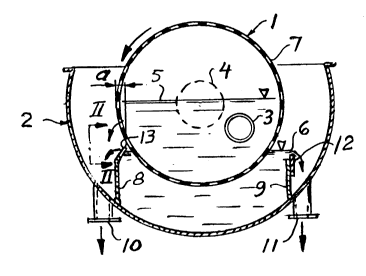Note: Claims are shown in the official language in which they were submitted.
CLAIMS
1. An arrangement in liquid filters comprising a liquid
container (2,21) and a filter rotor (1,20) with filtering
means (7) partly immersed in the liquid container, in which
the filtration is produced thereby that the surface (5,37)
of the incoming liquid suspension within the filter rotor is
kept at a higher level than the liquid surface (6,38) of
the filtrate outside the rotor in the container and in
which the filtrate is divided in two fractions, a so called
pre-filtrate and a clear filtrate, the pre-filtrate fraction
being produced by discharge means situated at that side of
the container, where the periphery of the rotor moves in
direction downwards into the liquid for extracting a
filtrate fraction, the said pre-filtrate fraction, from the
filtrate in the container at said side, while the clear
filtrate fraction is derived from the opposite side of the
container, where the periphery of the rotor moves in direc-
tion upwards from the liquid surface,
c h a r a c t e r i z e d in that the said discharge means
comprises a number of openings (13,16,18,27,31,33,41) in a
wall (8,17,26,30,32,40) separating the filtrate space at said
side of the container (2,21) from an outlet (10,22) for said
pre-filtrate, said wall (8,17,26,30,32,40) with its openings
(13,16,18,27,31,33,41) being so arranged that the openings are
situated opposite the filtering means (7) on the filter rotor
(1,20) near the liquid surface (6,38) of the filtrate and are
spaced apart relative to each other along the filtering
means of the rotor, through which openings (13,16,18,27,31,
33,41) the pre-filtrate fraction can flow to said outlet
(10,22) for the pre-filtrate.
2. An arrangement as claimed in claim 1, in which said wall
is a container wall (8,26) defining the filtrate space at said
pre-filtrate side of the container (2,21),
c h a r a c t e r i z e d in that the openings (13,16,27)
are formed in the upper edge of said wall (8,26) with the
upper limit of the openings situated at a higher level than
the liquid surface (6,38) of the filtrate and the lower limit
of the openings situated at a lower level than the liquid
surface of the filtrate, so as to form a number of restricted
overflow means for the pre-filtrate.
3. An arrangement as claimed in claim 2,
c h a r a c t e r i z e d in that the openings (13,27)
exhibit a smaller horizontal extension at the bottom (Fi-
gures 2 and 7).
4. An arrangement as claimed in claim 2 or 3 adapted to
so called drum filters comprising a drum shaped rotor,
c h a r a c t e r i z e d in that the upper edge of said
wall (8) provided with openings (13) for the pre-filtrate
is situated below the rotor (1) inside the horizontal pro-
jection of the rotor (1),as seen in a horizontal cross-
section, so that at least some pre-filtrate will flow
directly from the rotor to said outlet (10) for the pre-
filtrate outside said wall (8) (Figure 1).
5. An arrangement as claimed in claim 1,
c h a r a c t e r i z e d in that said wall comprises
at least one closed tube (17,30,32,40) communicating with
an outlet (10,22) for the pre-filtrate and provided with
longitudinally spaced openings (18,31,33,41) for the pre-
filtrate, which tube is so arranged in the container that
the openings are below the liquid surface of the filtrate.
6. An arrangement as claimed in claim 1,2,3 or 5 adapted to
so called disc filters comprising a rotor consisting of a
number of axially spaced, hollow discs provided with filtering
means on their sides,
c h a r a c t e r i z e d in that said wall provided with
openings (27,30) for the pre-filtrate has portions (26,30)
extending into the interspace between adjacent discs.
11
7. An arrangement as claimed in claims 5 and 6,
c h a r a c t e r i z e d by a number of tubes (30) ex-
tending into the interspace between each pair of adjacent
discs and communicating with a common outlet (22) for
the pre-filtrate.
8. An arrangement as claimed in claim 7,
c h a r a c t e r i z e d in that the closed tubes (30)
lead to an open channel (36) communicating with said out-
let (22).
9. An arrangement as claimed in claims 7 or 8,
c h a r a c t e r i z e d by means for supervising the
flow of pre-filtrate from each individual tube (30).
10. An arrangement as claimed in any of the preceeding
claims,
c h a r a c t e r i z e d by means (14,15,42,43) for ad-
justing the effective flow area of said openings (16,41)
